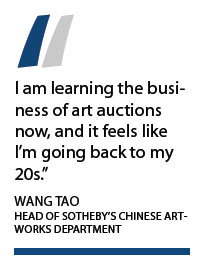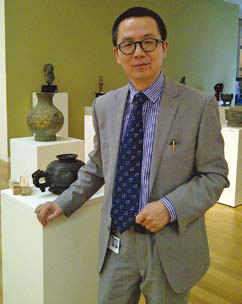From teaching to learning about the art market
Updated: 2013-03-15 12:00
By Liu Lian in New York (China Daily)
|
||||||||
|
Wang Tao, an archaeology professor-turned executive at Sotheby's, said he made the change to stand on the frontier of the international art market. Provided to China Daily |

Leaving behind decades of tenureship as a senior lecturer in Chinese archeology at The School of Oriental and African Studies (SOAS) in London, Wang Tao became the head of Sotheby's Chinese artworks department in 2012.
Although his transition from academia to the fast-paced world of art auctions might seem drastic, Wang's expertise in ancient Chinese bronzes, jades and the history of Chinese archeology made him a perfect fit for his current role as head of a department that is making major inroads in Asia.
"I was approaching 50 when [Sotheby's Vice-Chairman, Asian Art] Henry Howard-Sneyd) came to me with the offer, and I decided to make a change before it was too late," he said. "Others may prefer to stay in one place or stick with one job, but to me, sitting sedentary ages you."Wang's refined connoisseurship of Asian art caught Howard-Sneyd's eye, the vice-chairman said.
"I have always been impressed by his intellect and by his knowledge of the field," Howard-Sneyd said.
"Also, I was impressed by his interest in not just academia but also in engaging the commercial world. What Tao does in a sense is he brings to this role some very special extra elements of his connections to the museum and academic world. The art world is all interconnected. By knowing those people directly, we can engage them in meaningful ways."
As head of Sotheby's Chinese art department, Wang, 51, regularly travels to China and works closely with museums and universities there and in the US. He has also acted as an archeology consultant for the BBC and Discovery Channel, and as a judge for the annual Asian Art in London art fair.
Wang first became interested in Chinese archeology as a PhD student in Chinese cultural history at SOAS in 1987. He had moved to London with his wife Helen, a UK native whom he met while she was studying Chinese in Beijing.
Although he had studied Marxism as applied to Chinese literary theory, his introduction to the eminent Chinese historian Li Xueqing, who was a visiting scholar at SOAS at the time, ignited his passion for Chinese art and archeology, he said.
On trips to museums and flea markets, the historian nurtured Wang's curiosity about art objects and changed the course of his career, he said.
"It was a brand new field for me, at once daunting and exciting," he said.
"The relationship between professor and student then was different, much more relaxing and personal. Nowadays graduate schools feel more professional and institutional. Students attend seminars, work on their dissertations and prepare for the job market. In my days professors knew each student by name and we were more like friends."
The study of art should always revolve around real-life learning experiences, he said.
Visiting auction houses also fostered his growing interest in the field. "We talked to curators and auctioneers, and felt the pulse of the art market at a very close distance," he said.
"I learned a lot about Chinese antiques during our field trips to Christie's and Sotheby's."
Wang said he is excited to work for an auction house because in his opinion, they have become the frontier of the international art market.
"While in the past you studied art by locking yourself at a museum or an institution, now you see a lot more art works flowing through auction houses," he said. "Plus, they have the best research resources that help trace and appraise the market values. Sotheby's collection of catalogues provides a sea of knowledge."
"I am learning the business of art auctions now, and it feels like I'm going back to my 20s," Wang said.
lianliu@chinadailyusa.com
(China Daily 03/15/2013 page10)

 In Photos: 7.0-magnitude quake hits Sichuan
In Photos: 7.0-magnitude quake hits Sichuan
 Li Na on Time cover, makes influential 100 list
Li Na on Time cover, makes influential 100 list
 FBI releases photos of 2 Boston bombings suspects
FBI releases photos of 2 Boston bombings suspects
 World's wackiest hairstyles
World's wackiest hairstyles
 Sandstorms strike Northwest China
Sandstorms strike Northwest China
 Never-seen photos of Madonna on display
Never-seen photos of Madonna on display
 H7N9 outbreak linked to waterfowl migration
H7N9 outbreak linked to waterfowl migration
 Dozens feared dead in Texas plant blast
Dozens feared dead in Texas plant blast
Most Viewed
Editor's Picks

|

|

|

|

|

|
Today's Top News
Live report: 7.0-magnitude quake hits Sichuan, heavy casualties feared
Boston suspect cornered on boat
Cross-talk artist helps to spread the word
'Green' awareness levels drop in Beijing
Palace Museum spruces up
First couple on Time's list of most influential
H7N9 flu transmission studied
Trading channels 'need to broaden'
US Weekly

|

|








